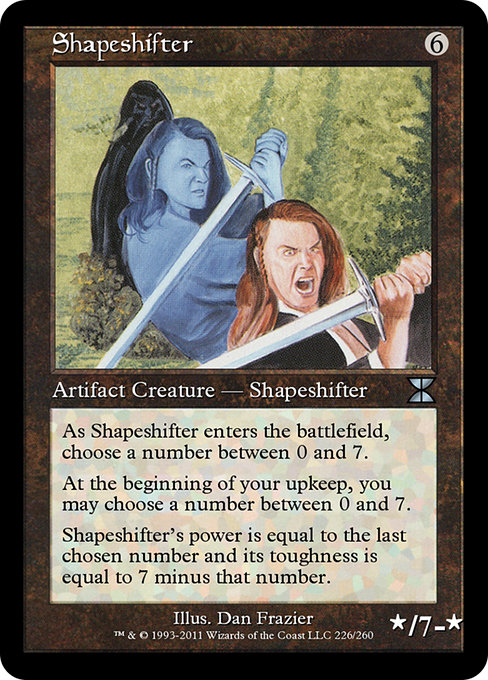
Image courtesy of Scryfall.com
Shapeshifters, Self-Expression, and the Craft of MTG Design
Magic: The Gathering has always thrived on more than just damage calculations and mana curves. It flourishes when players see themselves reflected on the battlefield—whether through a clever combination, a daring bluff, or a card that lets them sculpt the game to fit their temperament. The me4-era Shapeshifter is a compact manifesto for how a single card can invite a player to narrate their own approach to risk, tempo, and board presence 🧙♂️🔥. Its vocabulary—uncolored, artifact creature, mana cost of six, and a shifting power/toughness line tied to a number you choose—speaks to a design philosophy that honors player expression as a core engine of play.
From the moment this artifact creature enters the battlefield, you’re handed a small but powerful toy: choose a number between 0 and 7. The power becomes that last chosen value, while the toughness becomes 7 minus that value. Each turn, you may pick another number in the same range at upkeep. It’s a linear, rules-light invitation to narrate your own risk profile: do you push for a bigger punch now, or hedge and build toward inevitability as the game unfurls? That dichotomy—immediacy versus endurance—maps neatly onto a spectrum of player personalities, making the card a surprising lens on expression in design. ⚔️🎲
Design-wise, Shapeshifter has a quiet genius: it’s colorless, not tied to any particular mana color identity, and it wears its mathematical identity on its sleeve. In a sea of multicolored spells, a lone artifact creature with a mutable stat line asks players to project their choices onto a blank canvas. The mechanic rewards foresight and adaptation—the exact kind of meta-skill that feeds into how individuals claim ownership of their games. This is not just about what the card does, but what it asks you to do: what story do you want to tell with 0-7 power, and how do you balance the allure of a big stat line against the security of a lower one? 🧙♂️💎
The artist behind the image—Dan Frazier—brings a certain timelessness to the piece, a reminder that this card sits at the crossroads of classic ME4 design and the newer, more experimental spirit of master editions. The Masters Edition IV set itself is a curated corridor of reprints and rarities from Magic’s earlier eras, a bridge that invites veteran players to reminisce and newer players to feel the gravity of a design that refuses to stay within neat color boundaries. The card’s rarity—uncommon—and its modern-era presence in legacy and vintage playlists, along with its foil and nonfoil fineries, position Shapeshifter as a collectible token of a time when design experiments could still bloom under the constraints of power balance and board presence. 🎨
“Expression is the engine of play.” In MTG design, the most memorable cards often aren’t the ones that win the race outright, but the ones that enable players to choose how they want to run it. Shapeshifter embodies that ethos—an arithmetic mirror that invites self-definition through numbers as much as through tactics.
In practical play, the card stands as a test of tempo and patience. At six mana, Shapeshifter sits in a sweet spot where you’re committing to a long game without the immediate ramp. The evolving power/toughness ratio means you tailor your aggression to the moment: a higher chosen number pushes early impact but reduces survivability, while a lower number can keep you safer while you assemble a strategy around card advantage, artifact synergies, or protective countermoves. Because the calculation is simple—power equals last number, toughness equals 7 minus that number—the surface pressure is easy to explain, yet the strategic depth remains rich. This is classic MTG at its best: a card that teaches you about weighing risk, predicting opponent plans, and expressing your own playstyle through a single, elegant dial of options. 🔥🧭
From a broader design perspective, Shapeshifter demonstrates how a mechanic can become a player-expression conduit without requiring flashy interactions. It doesn’t rely on multicolor identity, tribal synergies, or complicated triggers. Instead, it leverages a universal concept—numbers, balance, and choice—and embeds it in a memorable silhouette: a colorless artifact creature with a variable power and a steady, predictable formula. The result is a familiar yet surprisingly personal experience: every table can tune the card according to their own preferences, making each game feel a little more like a reflection of the player at the table. ⚔️🎲
For fans who enjoy the tactile side of MTG culture—collecting foils, tracking rarities, or appreciating the artistry—the Shapeshifter era remains a darling. Its ME4 printing showcases how reprint sets can preserve classic concepts while inviting new audiences to engage with legacy mechanics. If you’re exploring how you want your MTG collection to express your tastes, this card is a reminder that sometimes the simplest dial—just a number—can carry the weight of a personality across dozens of games. 💎
Neon Tough Phone Case 2-Piece Armor for iPhone Samsung
More from our network
- https://blog.digital-vault.xyz/blog/post/how-cathars-companion-shapes-casual-win-rates/
- https://crypto-acolytes.xyz/blog/post/why-horror-gaming-thrives-on-twitch-secrets-revealed/
- https://transparent-paper.shop/blog/post/how-to-build-high-impact-productivity-template-bundles/
- https://blog.zero-static.xyz/blog/post/color-psychology-in-mtg-art-clay-revenants-earth-tones/
- https://crypto-acolytes.xyz/blog/post/solana-adoption-challenges-navigating-reliability-ux-and-regulation/